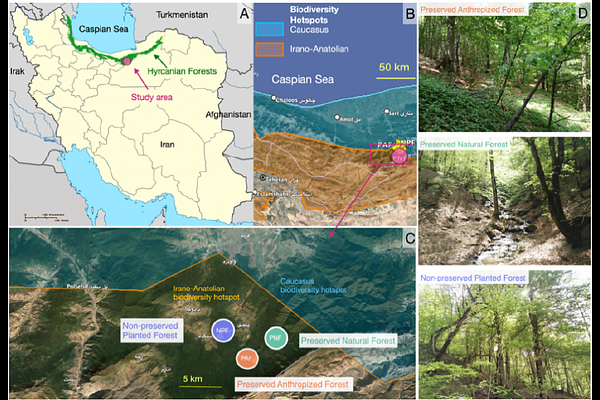Diversity and Community Structure of Collembola (Hexapoda) across sites and microhabitats in the Bula Protected Area, a UNESCO-Listed Hyrcanian Forest at the Crossroads of Two Biodiversity Hotspots (Iran).

Diversity and Community Structure of Collembola (Hexapoda) across sites and microhabitats in the Bula Protected Area, a UNESCO-Listed Hyrcanian Forest at the Crossroads of Two Biodiversity Hotspots (Iran).
Tully, T.; Shayanmehr, M.; Yoosefi Lafooraki, E.; Ghajar Sepanlou, M.; D'Haese, C.
AbstractBackground. The Hyrcanian Forests of Iran, a unique 850 km stretch of deciduous forest along the southern coast of the Caspian Sea, are renowned for their exceptional biodiversity, high levels of endemism and ecological integrity. The northern part of this forest massif is part of the Caucasian Biodiversity Hotspot, while its southern fringe extends into the Iranian-Anatolian Hotspot. The recognition of these forests as a UNESCO World Heritage Site has focused global attention on their protection, primarily from human disturbance. While the diversity of vascular plants is well documented, other groups, such as soil-dwelling arthropods, remain underexplored. This study aims to fill this knowledge gap by conducting inventories in different sections of the Hyrcanian forests, with a focus on Collembola, a potentially diverse but understudied group of soil fauna. The study was conducted to answer the following questions: Is the naturalness and degree of conservation of these forests reflected in the biodiversity of springtail communities? To what extent does the composition and diversity of these communities vary between different sites and micro-habitats within these forests? Methods. To answer these questions, 89 samples were collected over a two-year period from three different forest sites that had undergone contrasting forest management. Specifically, the study focused on three forest ecosystems, a preserved anthropized (planted) forest (PAF), a preserved natural forest (PNF) and a non-preserved natural forest (NPF), all located in the Bula protected area. Three types of microhabitats were sampled at each site, including moss, litter and dead wood. The springtails collected were identified and counted (approximately 3,000 individuals in total), allowing various biodiversity indices to be calculated for the communities as a whole, as well as by site and microhabitat. Soil samples were also analysed to compare soil properties between the three sites. Results. The results reveal an impressive diversity of springtails, with 73 morphospecies identified, belonging to 39 genera and 12 families. Of these, 49 could be identified to species level. The estimated total species richness ranged from 80 to 110 species. The analyses also revealed significant differences in species richness between sites, with two preserved sites (PAF and PNF) having a greater number of species compared to the non-preserved site (NPF), and in habitats, with greater diversity observed in dead wood, followed by soil and then mosses. A more detailed analysis of the communities showed a high degree of interspecific diversity in terms of abundance and distribution, without revealing strong patterns of ecological specialization for the majority of species. An analysis of cooccurrences showed that, in most cases species interactions appeared to be neutral. However, some pairs of species showed positive associations, while negative interactions were more marginal. The results of the soil properties showed no differences between the sites and no effect on the Collembola community. Discussion. The Bula Forest host particularly diverse Collembola communities. The results underline the importance of conserving these environments, which harbours a high diversity of springtails. Additionally, the results highlight the crucial role of dead wood as a substrate in supporting this biodiversity. The results also call for a more in-depth investigation of the factors influencing the presence, absence and abundance of species, as well as an exploration of the underlying causes of positive or negative species covariation.